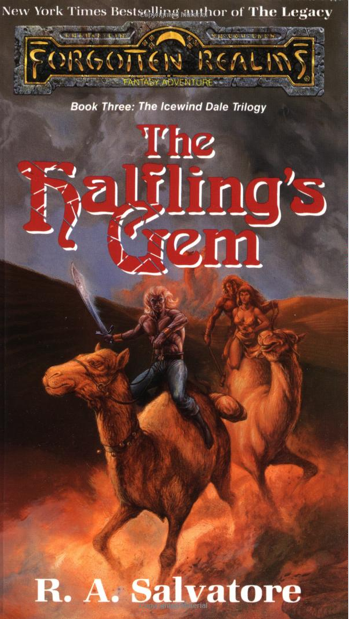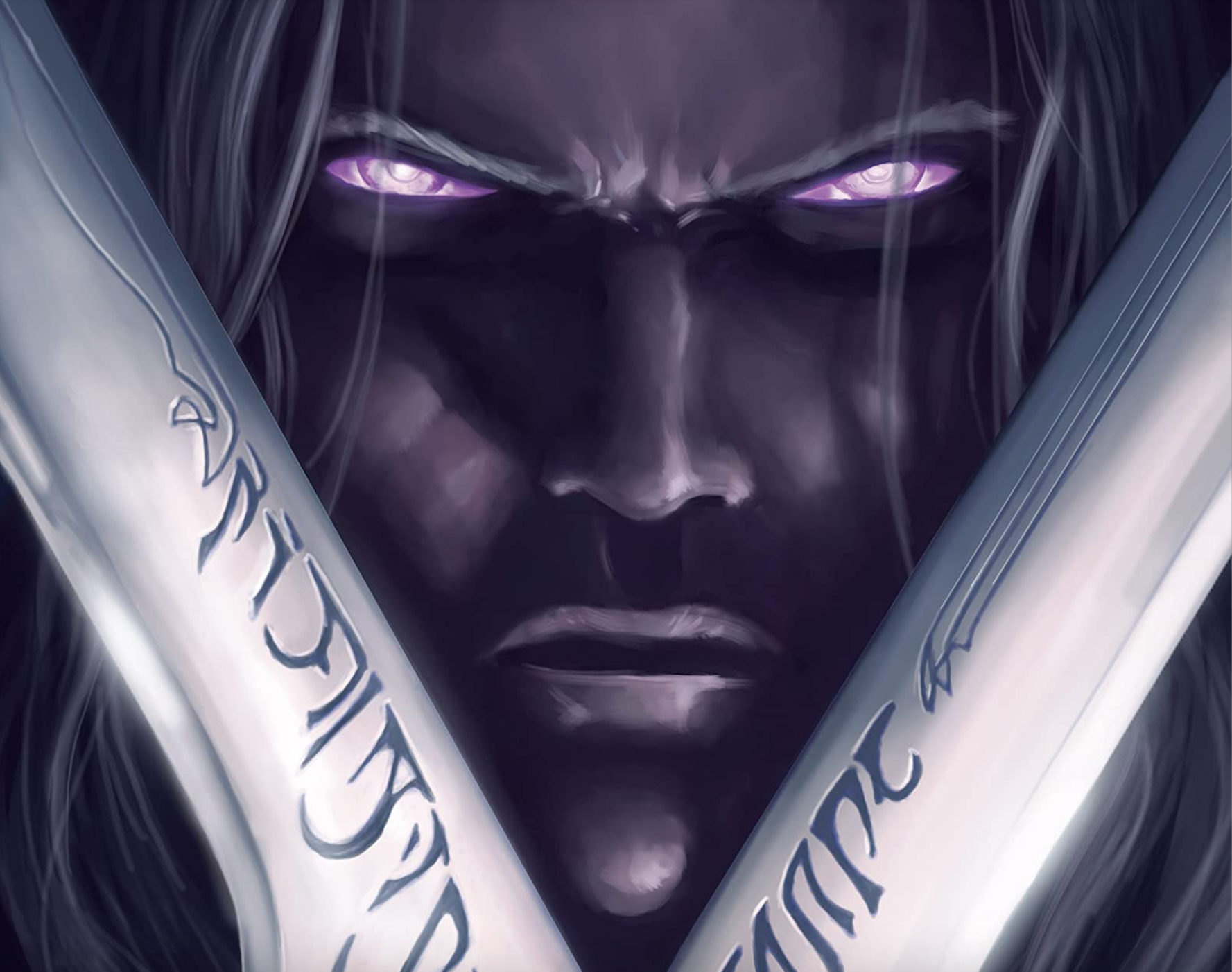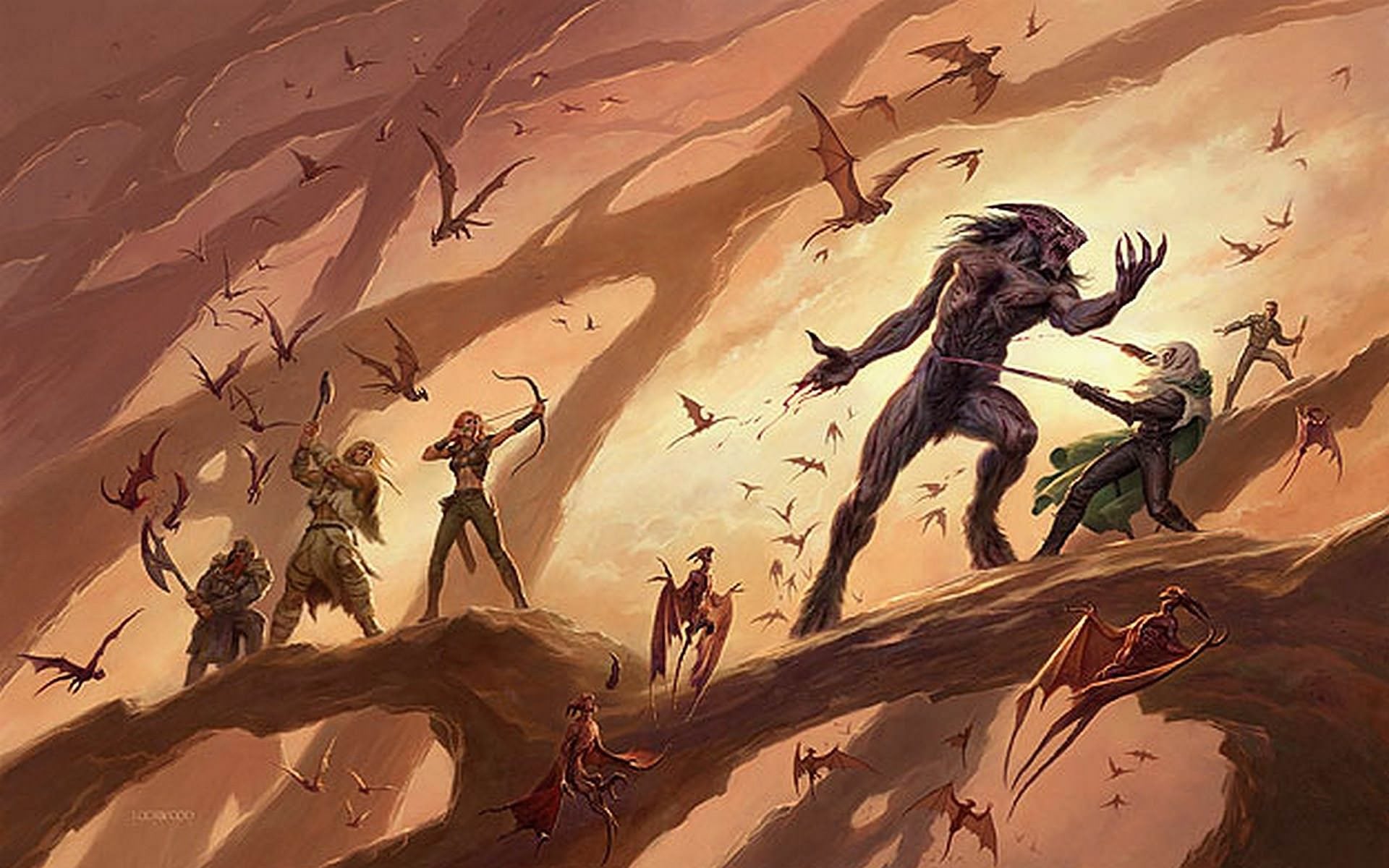When I started the Dungeons & Dragons & Novels series, I wanted to go through all the D&D fiction of yesteryear to see how they held up (or spectacularly fell to pieces). But if I’m being honest with myself, what I really wanted to reread was R.A. Salvatore’s original Icewind Dale trilogy. The Crystal Shard, Streams of Silver, and The Halfling’s Gem probably did as much to get me into fantasy as Lord of the Rings and David Eddings’ Belgariad, and I fell in love with Drizzt Do’Urden as much as any other nerdy 12-year-old. After rereading the final instalment in the series, I can cut my nerdy 12-year-old self some slack.
It is shocking to me that the same person who wrote The Crystal Shard in 1988 wrote The Halfling’s Gem in 1990. R.A. Salvatore’s growth as a writer is simply astonishing over the course of the Icewind Dale trilogy. Not that Gem is a masterpiece of fiction, but compared to Shard, it might as well be Game of Thrones. It has a clear plot that doesn’t feel like a transcript of a D&D session, it’s not a rehash of Tolkien like Streams, and the separate narrative threads weave together far more naturally. Furthermore, it’s not straining nearly as hard to be epic as the previous novels, which gives Gem a richness and intimacy the other books lacked.
As opposed to fighting an omnipotent idiot or an army of evil dwarves led by a dragon, The Halfling’s Gem is almost exclusively about the heroes trying to rescue Regis, who was kidnapped at the end of Streams of Silver by the assassin Artemis Entreri, and is now being taken to thieves’ guild leader Pasha Pook, from whom Regis had stolen the titular, magically hypnotic gem. Bruenor the dwarf had fallen to his death fighting the dragon Shadowgloom; his adopted, human daughter Catti-Brie was marshaling a wizard variety of armies to reclaim Mithral Hall, which the dragon had previously usurped. The impossibly noble and badass Drow elf Drizzt, along with the rash-but-learning barbarian Wulfgar, had given chase to Entreri and Regis as they head to Calimport, where Pook resides.
Eventually, it’s revealed that Bruenor didn’t die but was saved by a magical item (one of Drizzt’s swords, long story), he’s rescued and healed, and then he and Catti-Brie are given a flying, flaming magical chariot to join up with Drizzt and Wulfgar. Once reunited, the group enters the heavily stereotyped, Indian analogue of Calimport to rescue Regis and, more importantly, so Drizzt can have a rematch with Entreri.

Despite its title, The Halfling’s Gem is truly Drizzt’s novel. Most of the story is told through his perspective, he’s still bookending sections of the novel with his philosophical musings, and the book’s real plot is his conflict with Entreri, who are presented as two sides of the same coin — both supremely capable, badass warriors, except one pulled himself out of the literal darkness of Drow society to be good, while the other sank into evil. Entreri is even more obsessed with Drizzt than vice versa; the main reason the assassin kidnaps the halfling instead of killing him is to lead Drizzt into another duel. He even cuts off a few of Regis’ fingers to spur the dark elf on.
Their friend’s imminent death gives The Halfling’s Gem stakes and urgency that the previous two novels didn’t have, the first because the villain was a stone-cold imbecile, and the second because the group didn’t actually need to reclaim Mithral Hall, they just wanted to. But Regis isn’t just a halfling in a refrigerator for the others. He’s an active character, trying to escape and help his friends when they arrive, showing far more character than in the first two books combined. Entreri gets to show a different side of himself when he arrives at Pasha Pook’s villa, only to discover a wererat named Rassiter has become the crimelord’s second-in-command. Most of the novel’s plot progresses steadily and naturally; only the sudden gift of the flaming chariot is a contrivance.
Of course, the book has its problems, the most egregious being the Indian stereotypes used in and around Calimport, especially the toadying, treacherous merchant Sali Dalib. Catti-Brie, almost the sole female character in the book, is sidelined far more than she was in Streams of Silver. But there is one fundamental problem with The Halfling’s Gem that I remember also recognising when I first read the novel, more than 30 years ago.
The problem is this: Regis kind of has this coming. The halfling stole a crimelord’s most powerful magical artefact and has been trying to escape punishment ever since. The theft is never presented as having been done for some noble reason, so it means Regis knowingly committed a crime against his boss, and technically deserves to be punished for it. Drizzt even points this out during one of his soliloquies. It casts an uncomfortable pall over the final act of the novel, in which Drizzt and crew kill about a million wererats during their attempts to rescue their friend. Then, at the end of the book, Regis becomes the new head of the thieves’ guild only to later mess something up that requires him to run like hell again, clearly having learned nothing. It’s frustrating.
Another issue is how The Halfling’s Gem treats the prejudice Drizzt faces on his journey. In the first few books, the Drow would only get hard stares and/or be asked to leave, but he was almost exclusively with his companions who knew his true demeanour. Gem takes Drizzt to multiple major cities where his race would be an enormous deal if Salvatore hadn’t taken the easy out by having Drizzt come upon a magic mask that transforms him into a light-skinned elf. Now, to Salvatore’s credit, Drizzt has a lot of inner conflict about hiding his true self throughout the novel. It’s not done with any real nuance, but damned if it isn’t still satisfying when people, having seen his character while he’s disguised, overcome their prejudice when his mask is removed and recognise him for the hero he is.

There’s one other thing I’m not sure is a problem, although it might be. t’s something that has confused me from the very first time I read The Crystal Shard, and that’s Drizzt and Catti-Brie’s relationship. In all three books, Drizzt mentions her as his great love, but only in his philosophical musings which open each section. In the main narrative, Cattie-Brie’s romantic pairing is solely positioned as with Wulfgar, with Drizzt never mentioning anything but loving her as a friend. That is, until The Halfling’s Gem, when Drizzt rescues her from the plane of Tarterus [sic] and plants a big smooch on her when she’s unconscious. That’s certainly not cool, but it proves there’s a love triangle that is otherwise almost completely ignored. And then Cattie-Brie and Wulfgar are about to get married at the end of the novel! I know I’ve read at least a few more books in the Drizzt saga set after the Icewind Dale trilogy, but I don’t remember how this plays out. More importantly, did R.A. Salvatore really foreshadow Drizzt and Catti-Brie’s complicated romance back in the godawful Crystal Shard? It seems almost impossible, but the operative word there is almost.
I may be biased by my preteen Drizzt fandom, so feel free to blast me for it — I’m kidding, of course, no one has ever needed let alone asked my permission to trounce me online — but I honestly think The Halfling’s Gem is better than the Dragonlance trilogy, even Dragons of Winter Night, which I ranked at 17. Now, Gem and Winter Night have two very different sets of strengths, so it’s hardly a straight comparison. But Gem feels like it was written by the most talented, experienced author — which is absolutely wild given it’s the same guy who wrote The Crystal Shard a mere two years earlier. So The Halfling’s Gem rolls an 18, making it the new champ of the Dungeons & Dragons & Novels series.
Honestly, if you’re thinking about rereading Gem based on this retro review, I would suggest starting with Shard and pushing through the pain to read the entire trilogy, just to see Salvatore’s amazing evolution as a writer. Of course, you could also read all 37 novels in The Legend of Drizzt saga and see how far that evolution truly goes. Frankly, if it kept up at this rate, I’m shocked Salvatore hasn’t won a Pulitzer Prize.

Assorted Musings:
- One of the dwarven military commanders Cattie-Brie has summoned to help retake Mithral Hall is named General Dagnabit.
- Pasha Pook sticks Regis in a cage surrounded by other cages containing deadly giant cats like lions and tigers that constantly try to claw at their new neighbour. It’s a pretty clever idea for a villain.
- Wulfgar both punches and throws a camel at somebody in this book.
- At the end of the book, Regis summons Drizzt’s magical panther Guenhwyvar along with several other magical panthers who hunt down Rassiter’s wererats in Pasha Pook’s villa (it’s also a long story). I’m not proud to admit I had a mild chuckle at this line from Regis: “You know a better way to get rid of mice?”
- When Entreri is losing the duel in the sewers, he spits a mouthful of sewer water in Drizzt’s face. Even when I was a kid, the idea of someone willingly taking a big gulp of poop water and holding it in his mouth until it was time to strike utterly dumbfounds me.
- I’ve read too many good Dungeons & Dragons novels in a row, so it’s time to head back to the horrible world of Greyhawk with Artefact of Evil. Did D&D creator Gary Gygax improve between novels as much as Salvatore did? I sincerely doubt it!
